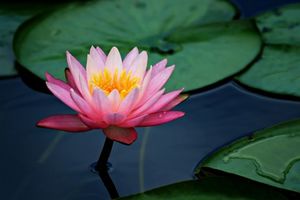Talk:Lotus flower
The lotus is the symbol of truth, auspiciousness, and beuty (satyam, shivam, sundaram). The Lord is also that nature and therefore, His various aspects are compared to a lotus (ie. lotus-eyes, lotus feet, lotus hands, etc). The scriptures and ancient literature extol the beauty of the lotus.
The lotus blooms with the rising sun and closes at night. Similarly, our minds open up and expand with the light of knowledge.
The lotus grows even in slushy areas, yet it remains beautiful and untainted despite its surrounds, reminding us that we too can and should strive to remain pure and beautiful within, under all circumstances. The lotus leaf never gets wet, even through it is always in water. It symbolizes the man of wisdom (gynaani) who remains ever joyous, unaffected by the world of sorrow and change. This is revealed in a shloka from the Bhagavad Gita:
| ब्रह्मण्याधाय कर्माणि सङ्गं त्यक्त्वा करोति यः ।
लिप्यते न स पापेन पद्मपत्रमिवाम्भसा |
brahmany adhaya karmani |
| He, who does actions, offering them to the Supreme, abandoning attachment, is not tainted by sin, just as a lotus leaf remains unaffected by the water on it[2]. | |
The auspicious sign of the swastika is said to have evolved from the lotus.
Ayurveda[edit]
Our bodies have certain energy centers described in the Yoga Shaastra as chakras. Each one is associated with lotus that have a certain number of petals. For example, the Sahasra chakra at the top of the head, which opens when the yogi attains self-realization, is represented by a lotus with a thousand petals. Also, the lotus posture (padmaasana) is recommended when one sits for meditation.
Dieties[edit]
- A lotus emerged from the navel of Lord Vishnu. Lord Brahma originated from it to create the world. Hence, the lotus symbolizes the link between the creator and the supreme Cause. It also symbolizes Brahmaloka, the abode of Lord Brahma.
- The Goddess of wealth, Lakshmi, sits on a lotus and carries one in Her hand.
Art & Architecture[edit]
- The Lotus is a common theme in both art and architecture. It is used in many different decorative motifs and paintings.
Names[edit]
Many babies are named after the lotus. These names include:
- Padma
- Pankaja
- Kamal
- Kamala
- Kamalakshi
Notes & References[edit]
- Swamini Vimalananda, Radhika Krishnakumar, "In Indian Culture, Why do we...", Central Chinmaya Mission Trust,2001


